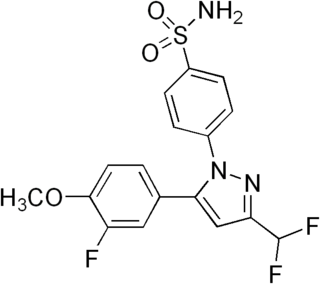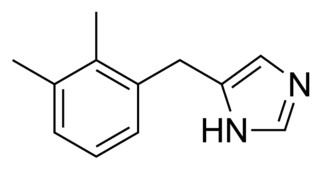
Yohimbine, also known as quebrachine, is an indole alkaloid derived from the bark of the African tree Pausinystalia johimbe; also from the bark of the unrelated South American tree Aspidosperma quebracho-blanco. Yohimbine is an α2-adrenergic receptor antagonist, and has been used in a variety of research projects. It is a veterinary drug used to reverse sedation in dogs and deer.

Oxymetazoline, sold under the brand name Afrin among others, is a topical decongestant and vasoconstrictor medication. It is available over-the-counter as a nasal spray to treat nasal congestion and nosebleeds, as eyedrops to treat eye redness due to minor irritation, and as a prescription topical cream to treat persistent facial redness due to rosacea in adults. Its effects begin within minutes and last for up to six hours. Intranasal use for longer than three days may cause congestion to recur or worsen, resulting in physical dependence.

Xylazine is a pharmaceutical drug used for sedation, anesthesia, muscle relaxation, and analgesia in animals such as horses, cattle, and other non-human mammals. Veterinarians also use xylazine as an emetic, especially in cats. It is an analog of clonidine and an agonist at the α2 class of adrenergic receptor.

Etorphine (M99) is a semi-synthetic opioid possessing an analgesic potency approximately 1,000–3,000 times that of morphine. It was first prepared in 1960 from oripavine, which does not generally occur in opium poppy extract but rather the related plants Papaver orientale and Papaver bracteatum. It was later reproduced in 1963 by a research group at MacFarlan Smith in Gorgie, Edinburgh, led by Kenneth Bentley. It can also be produced from thebaine.

Gonadorelin is a gonadotropin-releasing hormone agonist which is used in fertility medicine and to treat amenorrhea and hypogonadism. It is also used in veterinary medicine. The medication is a form of the endogenous GnRH and is identical to it in chemical structure. It is given by injection into a blood vessel or fat or as a nasal spray.

Tamsulosin, sold under the brand name Flomax among others, is a medication used to treat symptomatic benign prostatic hyperplasia (BPH) and chronic prostatitis and to help with the passage of kidney stones. The evidence for benefit with a kidney stone is better when the stone is larger. It is taken by mouth.

Butorphanol is a morphinan-type synthetic agonist–antagonist opioid analgesic developed by Bristol-Myers. Butorphanol is most closely structurally related to levorphanol. Butorphanol is available as the tartrate salt in injectable, tablet, and intranasal spray formulations. The tablet form is only used in dogs, cats and horses due to low bioavailability in humans.

Cyproheptadine, sold under the brand name Periactin among others, is a first-generation antihistamine with additional anticholinergic, antiserotonergic, and local anesthetic properties.
Papaveretum (BAN) is a preparation containing a mixture of hydrochloride salts of opium alkaloids. Since 1993, papaveretum has been defined in the British Pharmacopoeia (BP) as a mixture of 253 parts morphine hydrochloride, 23 parts papaverine hydrochloride, and 20 parts codeine hydrochloride. It is commonly marketed to medical agencies under the trade name Omnopon.

Dorzolamide, sold under the brand name Trusopt among others, is a medication used to treat high pressure inside the eye, including in cases of glaucoma. It is used as an eye drop. Effects begin within three hours and last for at least eight hours. It is also available as the combination dorzolamide/timolol.

Levobunolol is a non-selective beta blocker. It is used topically in the form of eye drops to manage ocular hypertension and open-angle glaucoma.

Cinchocaine (INN/BAN) or dibucaine (USAN) is an amide local anesthetic. Among the most potent and toxic of the long-acting local anesthetics, current use of cinchocaine is generally restricted to spinal and topical anesthesia. It is sold under the brand names Cincain, Nupercainal, Nupercaine and Sovcaine.

Promazine, is used as a short-term add-on treatment for psychomotor agitation. Its approved uses in people is limited, but is used as a tranquilizer in veterinary medicine. It has weak antipsychotic effects but is generally not used to treat psychoses.

Deracoxib is a nonsteroidal anti-inflammatory drug (NSAID) of the coxib class, used in dogs to treat pain associated with osteoarthritis, or to prevent pain following orthopedic or dental surgery. It is available as beef-flavored tablets.

Pentoxyverine (rINN) or carbetapentane is an antitussive commonly used for cough associated with illnesses like common cold. It is sold over-the-counter in the United States as Solotuss, or in combination with other medications, especially decongestants. One such product is Certuss, a combination of guaifenesin and pentoxyverine.

Palonosetron, sold under the brand name Aloxi, is used for the prevention and treatment of chemotherapy-induced nausea and vomiting (CINV). It is a 5-HT3 antagonist.

Detomidine is an imidazole derivative and α2-adrenergic agonist, used as a large animal sedative, primarily used in horses. It is usually available as the salt detomidine hydrochloride. It is a prescription medication available to veterinarians sold under various trade names.

Isoxsuprine is a drug used as a vasodilator in humans and equines. Isoxsuprine is a β2 adrenoreceptor agonist that causes direct relaxation of uterine and vascular smooth muscle via β2 receptors.

Alfaxalone, also known as alphaxalone or alphaxolone and sold under the brand name Alfaxan, is a neuroactive steroid and general anesthetic which is used currently in veterinary practice as an induction agent for anesthesia and as an injectable anesthetic. Though it is more expensive than other induction agents, it often preferred due to the lack of depressive effects on the cardiovascular system. The most common side effect seen in current veterinary practice is respiratory depression when Alfaxan is administered concurrently with other sedative and anesthetic drugs; when premedications aren't given, veterinary patients also become agitated and hypersensitive when waking up.

Zilpaterol is a β2 adrenergic agonist. Under its trade name, Zilmax, it is used to increase the size of cattle and the efficiency of feeding them. Zilmax is produced by Intervet, a subsidiary of Merck & Co., and marketed as a "beef-improvement technology". Zilpaterol is typically fed in the last three to six weeks of cattle's lives, with a brief period before death for withdrawal, which allows the drug to mostly leave the animal's tissues.



















